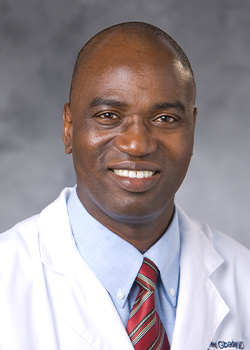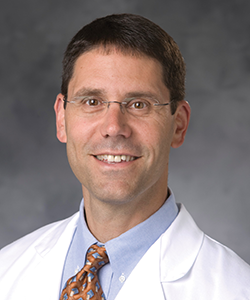
The School of Medicine Bolsters the Physician-Scientist Pipeline
Health challenges across the globe —everything from climate change to infectious disease and better treatment options for patients —precipitate the need for skilled physician-scientists: physicians who see patients in the clinic and who also devote time to scientific research.
The in-depth knowledge of the cellular and molecular basis of disease that physician-scientists gain in the lab gives them unique insights into complex medical problems in the clinic —and the experience they gain interacting with patients in the clinic in turn informs their research. This dual role gives physician-scientists unique perspectives on health challenges that are critical for advancing biomedical research and care.

Rasheed Gbadegesin, MD, Wilburt C. Davison Distinguished Professor and associate dean of physician-scientist development at Duke University School of Medicine, is a pediatric nephrologist. He’s also a scientist who conducts basic and translational genomics research involving patients with kidney disease.
“What I find fascinating about that is moving from clinic to bench side and back from bench side to clinic,” Gbadegesin said. “I can collect samples from a patient, bring them to my lab, and relate to who this patient isand why I am studying the patient.”
Despite the important role they play, the number of physician-scientists in the workforce is dwindling. Thirty years ago, 4.5% of physicians also participated in research. Today, that rate is just 1.5%.
The School of Medicine is actively working to bolster this necessary workforce, offering a range of programs and pathways for students and early career physicians interested in pursuing both research and clinical care.
Training Leaders
Most students enrolled in the MD program conduct scientific research —the entire third year of Duke’s unique curriculum is dedicated to research or other scholarly activity —and, of course, the school’s biomedical PhD programs are research-focused. And because Duke emphasizes cross-departmental and interdisciplinary education and training, students have many opportunities to craft paths of study that incorporate a range of fields.
The Medical Scientist Training Program (MSTP) is specifically designed to train physician-scientists. Duke’sMSTP, the nation’s fourth oldest such program and consistently ranked among the best, offers a targeted path for students with strong backgrounds in science who are interested in careers in the medical sciences and academic medicine.
The program, which leads to both MD and PhD degrees, typically integrates the clinical curriculum of the Duke School of Medicine with a graduate education in scientific disciplines relevant to medicine. MSTP students generally spend two years on core basic science and clinical experiences, then move into graduate research for 4-5 years before returning to the MD program for one year of individualized clinical training.

“This path is designed for students who want to take care of patients and also do cutting-edge research thatwill advance biomedical science and improve health,” said Christopher Kontos, MD, HS’93-’97, professor of medicine and director of the MSTP. “The MD-PhD has a grounding in clinical medicine that helps them view scientific problems from a clinical perspective and helps them think about clinical problems from a scientific perspective.”
The MSTP is also addressing one of the challenges facing the physician-scientist pathway: making sure young people know the path exists. Duke’s MSTP students are actively engaged in outreach to high school and younger students, as well as college undergraduates, to make them aware of the possibilities and opportunities available to those with an interest in both science and medicine.
Addressing Challenges
The Duke Office of Physician-Scientist Development (OPSD) works to improve engagement and address the challenges that have deterred students and physicians from pursing the physician-scientist career path.
Among those obstacles are the potential burden of student loan debt, the length of time necessary to complete medical school specialty training, limited opportunities to engage in research during specialty training, and the competitive nature of applying for and receiving research grants.
To address these challenges, OPSD has launched initiatives in education and professional development, research funding, and scholarships, and has created additional opportunities to conduct research during clinical training and provided career mentoring for medical students engaged in conducting scientific research.
OPSD has successfully competed for funding to support research in residency and to retain current physician-scientists. Gbadegesin and colleagues are also working to expand the range of backgrounds represented in the physician-scientist workforce by providing early exposure through summer and year-long research experiences for non-Duke and post-baccalaureate students. They have provided scholarships to medical students who wish to extend their third-year research year into two years at no additional cost.
Through awards and other resources, OPSD provides continuity of research progress during medical students’ return to clinical training. And the office provides mentorship and professional development opportunities to junior faculty to help them succeed in their independent research careers.
Daniel Joh, MD, PhD’19, a Duke resident in plastic surgery and a graduate of Duke’s MSTP, can’t imagine a career without living in both the clinical and scientific worlds. He notes that immersion in both is key. “It’s a matter of timing of meaningful exposure to decide to do both,” he said.
A Necessary Workforce
The School of Medicine’s programs to boost engagement and increase the number of physician-scientists in the workforce are vital. The world needs them to succeed. Consider the COVID-19 pandemic: physician-scientists played a key role in rapidly learning about the disease and developing vaccines and treatment options.
The efforts made by the MSTP, OPSD, and others at Duke to prepare the next generation of physician-scientists are opening the doors to exceptional students, increasing retention of junior faculty, and getting more trainees invested in this vital career path.
“We need to continue to treat and invest in human resources for biomedical research in order to sustain the advances we’ve made,” Gbadegesin said, “and to make more.”
Story originally published in DukeMed Alumni News, Fall 2022.
Read more from DukeMed Alumni News